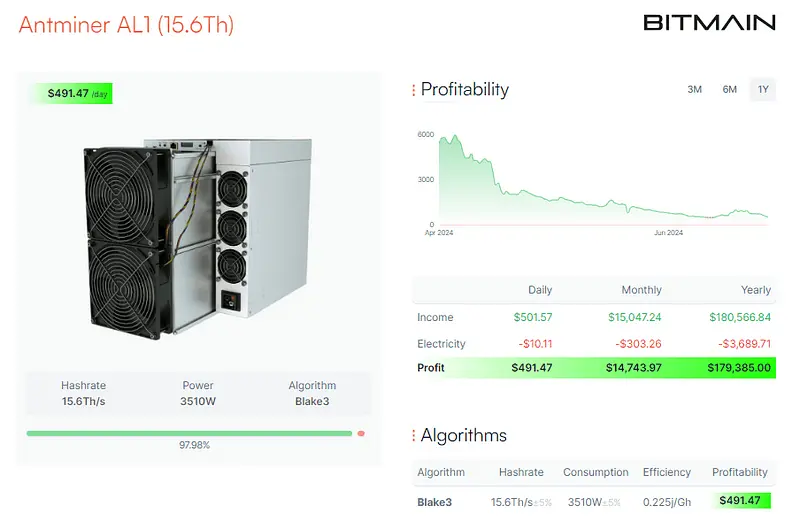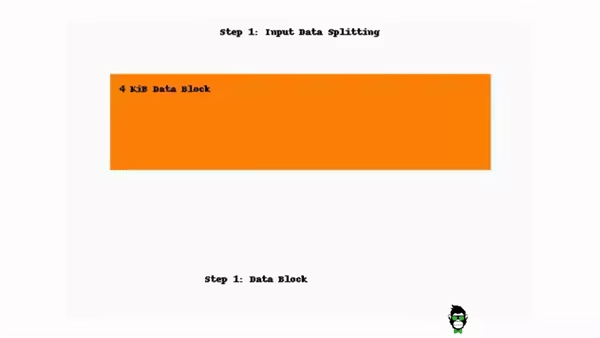Experience the Future of Intelligent Investing Today
Back To Top
Experience the Future of Intelligent Investing Today
Crypto mining continues to be a lucrative venture for those who invest in the right technology. The Bitmain Antminer AL1 and its advanced version, the Antminer AL1 Pro, are among the latest mining rigs promising substantial daily profits. Moreover, these rigs offer with a paidback period of around 2 months.
In this article, we’ll the discuss the following aspects:
The Bitmain Antminer AL1 is a high-performance mining rig specifically designed for Alephium (ALPH). It offers a hashrate of 15.6 TH/s and consumes 3510W of power. This rig achieves an energy efficiency of 0.23 J/GH.
Additionally, it features a four-fan cooling system, enabling it to operate efficiently within a temperature range of 5 to 45°C. By mid-July 2024, miners can expect a daily profit of around $600.
In September 2024, Bitmain will release the Antminer AL1 Pro, which builds on the original AL1. This upgraded model provides a higher hashrate of 16.6 TH/s and consumes 3730W to enhance performance. Consequently, it is projected to yield a daily profit of approximately $730.

Profitability Overview of Antminer. Please note that profitability will change over time due to factors like market conditions, energy costs, and network difficulty. Source: asicminervalue.com
Alephium mining involves using the Blake3 hashing algorithm to solve complex mathematical puzzles.
Alephium operates on a Proof-of-Work (PoW) system. In this system, miners compete to find a nonce, which is a variable adjusted to generate a hash meeting specific criteria, such as leading zeros.
Miners test various nonce values until they produce a valid hash. Once found, the correct nonce gets added to the block. This process secures the network because altering any block would require redoing the proof-of-work.
Blake3 is a cryptographic hash function built for high performance. It is faster than SHA-2 and SHA-3. Those interested in more technical details should visit Blake3’s official git repo.
Blake3 provides strong resistance to collision and pre-image attacks. It also supports parallelism by using multiple CPU cores. Key characteristics include:

First, Blake3 splits data into chunks. Then, it processes these chunks in parallel using multiple CPU cores. Finally, the chunks combine to form a secure cryptographic hash.
The mining process can be broken down into several steps:
Block Header Construction:
The block header includes the previous block’s hash, timestamp, Merkle root, difficulty target, and a nonce.
Merkle Root Calculation:
After constructing the block header, miners organize transactions in the block into a Merkle tree. The root of this tree is then added to the block header. Moreover, this step ensures the integrity of all transactions in the block.
Hashing with Blake3:
Miners proceed by trying different nonces to find a hash that meets the difficulty target. At this stage, they hash the block header using Blake3, which produces a 256-bit hash.
Difficulty Target:
The difficulty target is a 256-bit number that defines how challenging it is to find a valid hash. A valid hash must be less than or equal to this target. The difficulty adjusts based on the network’s total hashing power.
Given a block header H and a nonce N, the hash is calculated as:
The resulting hash is then checked against the difficulty target T:
Miners iterate over possible values of N to find a valid hash. This process can be described as:
Where Nk is the nonce that produces a valid hash.
The probability P of a miner finding a valid hash on a single attempt is given by the ratio of the target T to the maximum possible hash value M:
Given the maximum hash value for a 256-bit hash is 256−12^{256}−1, the probability is:
Let’s analyze the profitability of Alephium mining using the Antminer AL1, considering its hash rate, energy consumption, and overall profitability.
The Antminer AL1 operates at a hash rate of 15.6 trillion hashes per second (15.6 TH/s). This means it can test 15.6 trillion nonces every second. This enhances its chances of solving a block.
The Antminer AL1 consumes 3510 watts (3.51 kW). Daily energy consumption can be calculated as follows:

Newsletter